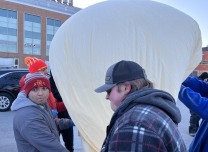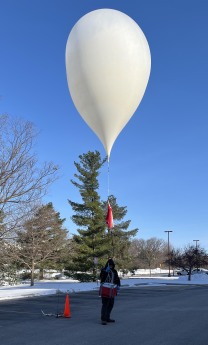 Iowa State University students inflate a high-altitude balloon and prepare for launch in the Howe Hall parking lot on March 23. The launch will prepare them for a similar experiment during the upcoming solar eclipse. Photo by Fred Love. Larger image. |
AMES, Iowa – Early spring snow clung to the tree branches surrounding the Howe Hall parking lot as a dozen Iowa State University students began filling a high-altitude balloon with hydrogen just after dawn on Saturday, March 23.
They popped the hood of a sport utility vehicle and attached the battery to a laptop they use to predict and track the balloon's movement. They blocked off several adjoining parking stalls and wheeled in a cart carrying a heavy tank filled with hydrogen gas.
Then they attached a hose to the base of the balloon and started the painstaking inflation process.
"Start flow. Give me 20 PSI," said Kellan French, a senior in aerospace engineering from Weeping Water, Nebraska, after he secured the hose to the balloon. Air started flowing from the hydrogen tank into the balloon with a hiss.
"Boost me up to 40," French called a few moments later. "Then slowly go up to 80."
At first, the balloon looked like a flat sheet, but it inflated as the minutes ticked by, taking on the shape and color of an enormous egg standing on its narrow end. The pale sky was clear and the wind minimal, which meant the conditions were right for launch, frosty temperatures notwithstanding.
With the balloon fully inflated, the team members counted down from five and French released the balloon. It ascended into the cloudless sky, carrying a payload of electronics capable of sending and receiving radio signals. It remained visible for several minutes, a pale dot rapidly receding into a sea of blue, but it soon reached an altitude beyond the team's ability to track with the naked eye.
The High Altitude Balloon Experiments in Technology (HABET) course at Iowa State University conducts a handful of these balloon launches each semester. The balloons allow them to gather data at the highest reaches of Earth's atmosphere. They'll follow the recent launch with perhaps their most anticipated experiment yet on April 8, when they travel to Illinois to launch a balloon during the upcoming total solar eclipse that will cross North America.
The March 23 launch helped the team members improve their familiarity with the gear and procedures they'll use during the eclipse to make sure they get the most from the experience, said team leader Brody Echer, a senior in information management systems from Huxley.
"Launching a balloon is a really satisfying experience when everything works the way you plan," Echer said. "It's a team effort, and you learn something new every time."
Nearly outer space
 Kellan French, a senior in aerospace engineering, prepares to launch the fully inflated balloon. Photo by Fred Love. Larger image. |
The balloon launched on March 23 reached an altitude of around 77,000 feet. Other balloons used by the students can reach even higher than that, to around 130,000 feet. That puts the balloons above 99% of the Earth's atmosphere.
It's not quite outer space, but it's close, said Matthew Nelson, assistant teaching professor of aerospace engineering and director of the Make to Innovate program, which encourages students to pursue solutions to real-world aerospace challenges. Nelson serves as the ballooning team's director, and Make to Innovate manages the course.
"Reaching space is expensive. Launching something into outer space costs millions of dollars. With high-altitude ballooning we get access to near space at a fraction of the cost," Nelson said. "These balloons get so high up, you can see the curvature of Earth and the blackness of space. We've done some really cool experiments at those altitudes."
The team has tested how the near vacuum conditions of the upper atmosphere affect instruments. They also collect data on atmospheric conditions and light.
The balloons expand as they ascend and eventually burst. When they do, a parachute opens and carries the equipment safely to Earth. It can take a couple hours for the payload to return to the ground, and winds can carry the parachute for miles. The team utilizes software that predicts where the parachute will land, and they send a recovery team to retrieve the equipment. The March 23 launch landed about 61 miles southeast of Ames near Malcolm. The team files a form with the Federal Aviation Administration before every launch to make sure they have permission to access the airspace.
Preparing for the solar eclipse
On Monday, the moon will pass between the sun and the Earth, blocking out the sun across a major stretch of North America. The HABET team will travel to Carbondale, Illinois, for Monday's total solar eclipse so they can launch a balloon into the path of totality to take readings on how an eclipse affects conditions in the upper atmosphere. The team will join a NASA-led network of high-altitude balloons recording data during the eclipse.
The balloon will take readings on temperature, air pressure and humidity to see how those variables fluctuate before, during and after the solar eclipse at different layers of the atmosphere. They'll also livestream video of the eclipse from their balloon.
Seven team members will make the trip along with Nelson.
The team has deep ties with NASA and bases many of its operational procedures on how NASA conducts balloon experiments. Some of the team's funding comes from the Iowa Space Grant Consortium, which connects Iowans with NASA-relevant research opportunities and internships. Iowa State University is a core member of the consortium.
Iowa Space Grant Consortium Director Sara Nelson said HABET trains students to aim high and explore science, technology, engineering and mathematics.
"What they do with the balloons is hands-on innovation training," Sara Nelson said. "They're taking what they learn in class and applying it in creative ways. The students that come here get the unique experience of literally seeing their work launched into near space."






